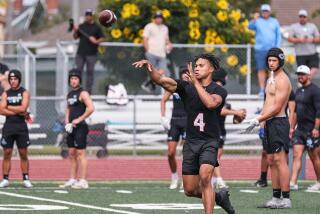Section Teams Working to Improve Their Health Care Plans : High Schools: Especially in North County, full-time certified trainers are becoming an important part of athletic programs.
SAN DIEGO — Alan Johnson has always believed that certified athletic trainers should be a requirement for every high school sports program. That belief was reinforced six years ago.
Johnson, then principal at Vista, witnessed an incident that almost cost an athlete his life.
“During a soccer match between Vista and San Marcos, two kids collided, and one of them stopped breathing,” recalled Johnson, now principal at Rancho Buena Vista and president of the North County Conference. “Our coach was not trained in CPR (cardiopulmonary resuscitation), and the kid was just lying there. . . . Fortunately, a kid on our team had the presence of mind to run and get our full-time trainer from his office. The trainer knew exactly what to do and saved his life. If the trainer wouldn’t have been there, the kid would have died.”
Even though coaches are now required to have CPR and American Red Cross training, Johnson said he’d rather have a professional deal with catastrophic situations.
To Brian Barry, president of the California Athletic Trainers Assn. and head athletic trainer at San Diego State, the need for certified athletic trainers in every San Diego Section high school seems logical--especially in the litigation age.
“From a legal standpoint, if you are going to have an athletic program, every athlete at every level deserves the best possible care,” Barry said. “With all the lawsuits going on, you can’t afford not to have a trainer. A trainer can reduce athletic insurance premiums.”
Mike Nesbitt, head trainer at Northern Arizona University and the man who spearheaded a drive in Arizona that regulated the practice of athletic trainers, said the need is even more fundamental.
“Schools wouldn’t open their doors without a school nurse on site, so why shouldn’t kids who participate in sports after school be afforded the same health-care opportunities?”
Many school administrators around the country are beginning to ask the same kind of questions. During the past five years, the number of certified athletic trainers in U.S. high schools has grown from 1,200 to 4,000.
San Diego, and especially North County, is part of that growth. Each of the North County Conference’s 15 schools have trainers on campus after school, and more than half are working full-time.
Other districts, such as Grossmont and San Diego Unified, are not as well-equipped.
San Diego Unified uses San Diego Sports Medicine Center trainers on a weekly basis. Grossmont uses physical education attendants or equipment managers who are trained in CPR and Red Cross.
The difference in philosophy?
School administrators say it’s simple.
Money.
“I don’t think we can ever do enough (to prevent injuries), but we just don’t have the money,” said Wayne Debate, secondary athletic manager for the San Diego Unified School District. “We’ve really never tried to do more than (hire outside trainers), because of the price. We’re just barely making it now.”
Linda Esquerra is a trainer at the San Diego Sports Medicine Center and coordinates the high school training program with San Diego Unified. She said she understands that her center is a shortcut for districts that can’t afford full-time trainers.
“We come out to the schools once a week and evaluate any injuries that have occured in the past week and refer them to their own physician or give them some guidelines to follow,” said Esquerra, who also offers low-cost physicals three times a year and injury clinics to athletes every Saturday.
But Esquerra admits her program will never be comparable to having an on-site trainer.
“With a trainer at the school full-time, you have more continuity and consistency in your care,” Esquerra said.
Mike Eddy, director of administrative services for the Grossmont District, is using two graduate assistants at Granite Hills and Helix on a pilot basis.
“We could still drop this program, but we’re looking at this as another approach,” Eddy said. “If there’s a significant decrease in injuries, we’d like to look at it.”
El Camino’s Clayton Higgins is one of the new breed of trainers who are also full-time teachers. Higgins, who majored in sports medicine in college, teaches three science classes and an athletic training class in addition to serving as the school’s trainer. He is one of four trainers in the North County who also teach.
“It’s a great combination,” Barry said. “That’s a very viable solution to getting more trainers in the high schools. It also makes the trainer coming out of school that much more marketable.”
Higgins, who is paid a coach’s salary for his after-school training work, said a teacher/trainer is the perfect mix.
“A lot of trainers aren’t interested in the teaching side of it,” he said. “I got really lucky. I think me being there takes a lot of pressure off the coaches.”
Herb Meyer, football coach at El Camino, said he remembers the days when all the pressure was on them.
“My first 15 years (coaching) at Oceanside, I was a trainer,” Meyer said. “That was part of your job. I was a science major, and I knew enough about the anatomy and physiology, but I’m sure there were a lot of other coaches who didn’t.”
Before Higgins came along, Meyer said, El Camino used trainers out of the physical therapy center at Tri-City Hospital.
“That was a problem because they weren’t around all the time, especially for practice,” Meyer said. “Clayton is at all the practices and home sporting events (and some road events). From all the situations we’ve been through, this is the most ideal.”
Barry is pleased with the progress that has been made over the past decade, but he says it is not nearly enough.
“It’s quite a bit better than it once was, but we are the ones trained,” Barry said. “In many situations, the coach is still the supervisor, and the coach is not trained to do certain things. The trained professional is.”
And what exactly is a trained professional?
A certified trainer must have a bachelors degree, work a minimal of 1,800 hours under a certified athletic trainer and pass practical and written exams.
John LeGear, public relations director for National Assn. of Athletic Trainers in Illinois, said there are 19 states that regulate the practice of athletic trainers.
“If they call themselves athletic trainers, they have to prove it--meaning they have to be certified,” LeGear said.
In 1986, California came close to passing a similar bill, but Gov. George Deukmejian vetoed it. LeGear said Deukmejian was worried the bill would make it mandatory for all schools to hire certified trainers.
LeGear said the notion of mandatory trainers in all schools is unrealistic but not outlandish.
“We don’t think it’s too much to ask to have one qualified medical person to be in charge of some 400 to 500 students,” LeGear said. “It comes down to, what price safety?
“Most people see the fundamental logic, but prevention’s a very difficult thing to sell. They say, ‘We haven’t had a kid paralyzed, so why do we need one?’ ”
Kendall Webb, San Diego Section commissioner, is not opposed to the idea of a trainer in every school but also sees it as unrealistic.
“I’d like to see it, but there are so many schools with higher priorities,” Webb said.
Barry said part of his campaign will be geared toward convincing Webb that athletic trainers should receive a higher priority than they have been.
“We have to educate people,” he said. “I am speaking to all different groups--Kiwanis Club, booster clubs, parent teacher associations. We have to convince people that catastrophes can happen at any level. They are tough to plan for.”
But Barry said that even most minor injuries should only be handled by qualified trainers.
“If a kid pulls a muscle, who’s going to be there to care for the kid and to rehabilitate the kid?,” he said. “Surely not a coach. The coach doesn’t want that responsibility.”
Still, Barry he is encouraged by the statistics that show that 20% of the nation’s schools now carry certified trainers.
“We don’t just throw our arms up anymore,” Barry said. “We look at the growth.”
More to Read
Get our high school sports newsletter
Prep Rally is devoted to the SoCal high school sports experience, bringing you scores, stories and a behind-the-scenes look at what makes prep sports so popular.
You may occasionally receive promotional content from the Los Angeles Times.






